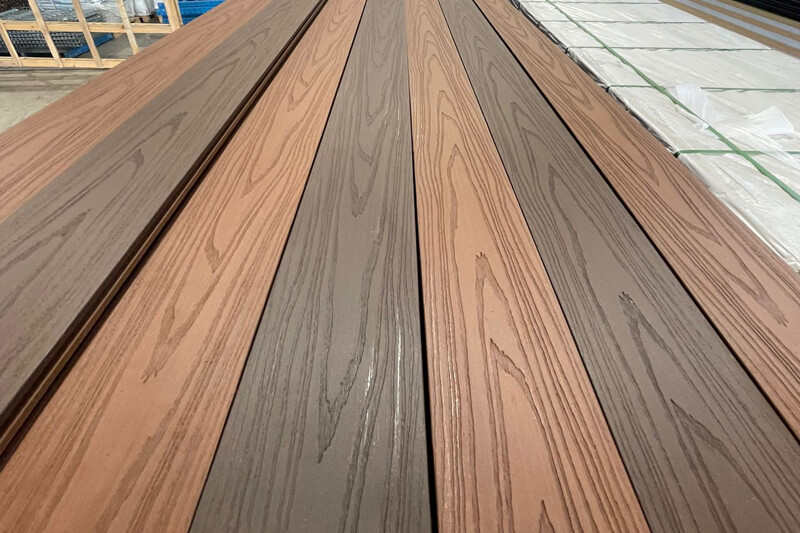This mixture of natural looks and modern technology has revolutionized how people can enjoy the outdoors with WPC decking Melbourne. WPC decking is an increasingly popular option among the homeowners and the contractors since it has paired natural warmth and beauty of wood with the strength and ease of maintenance of plastic. However, a successful installation requires a well-planned and precisely implemented process approximating the best practices in the industry. So, here is a step-by-step installation guide for WPC decking that covers all the details.
Understanding WPC Decking:
While learning the decking process of WPC, it’s vital to be aware of what it is and how it operates. Wood decking rots, decays, and attracts insects. However, WPC decking is constructed of a unique recycled wood fiber and plastic mixture. This unique blend creates a durable, weatherproof, long-lasting textile.
WPC floor boards are available in a variety of shapes and sizes including solid and hollow ones. hollow boards are good choices for areas that have low traffic and are within the preset budget; they are lighter and less costly. On the other hand, the solid boards are stronger and more stable and they can be used in places with a lot of foot traffic and where extra structural support is required.
Pre-Installation Preparation:
The preparation and the planning are crucial for any WPC decking installation to end up good. First, contemplate over the project site and look for any problems or issues that might arise. See that the area is clear from trash, plants, and structures that may interfere with the work process.
Secondly, look at the site’s structure so that it can hold the weight of the decking materials and endure the traffic of the space meant for. Study the regional building codes and regulations, ensuring that you comply with them. Also, obtain any permits or approvals that the law requires.
After your evaluation is done, draw a detailed installation plan to indicate the direction of your project, its design and the materials used. While planning the layout of your wooden composite decking, consider things like sun exposure, drainage and entry points so that it performs well and looks beautiful.
When you have the installation plan, it’s time to gather all the tools and materials you will need for the job, like WPC boards, joists, screws, and other components. Propering high-quality fasteners and tools that do not rust will make the fitting process smoother and lower the probability of things being broken too soon.
Installation Techniques:
It takes hours and hours of preparation but finally, it is time to get below your hands and begin the installation. To get skilled results, follow these tips and tricks from experts:
Establish a Solid Foundation:Support level of your wooden deck plays a key role in its longevity. Begin with a secure foundation that utilizes pressure-treated wood or stainless steel joists. Check with the manufacturer to find out how far apart the joists should be to hold the weight of the WPC boards. If you don’t, the boards will sink or warp over time.
Allow for Good Drainage:The water should not accumulate which this leads to mold, mildew, and rot. Include a small slope to the deck so that water flows away from the deck and towards marked drainage points. Protect the deck from water damage by putting down waterproof sealant or flashing tape on the outside.
Choose the Right Fastening Method: The connection of the WPC boards to the substructure can be different and each of them has their own advantages and disadvantages. Decide on the fastening technique for your project. The screws are appropriate for surface mounting because they hold things firmly in place. However, they are more noticeable, and it can therefore take longer to install. Adding to the smooth appearance, concealed fastening systems conceal the fasteners under the decking surface.
Mind the Expansion Gaps:WPC decking may increase and decrease in size because of temperature and humidity. Leave enough spacing between the boards during installation so that they are not warped or buckled with the natural movement. Abide by the manufacturer’s guidelines and find out what gap size matches the board and its surroundings.
Conceal Edge Profiles:To make your project look polished and finished, consider using edge profiles and facia boards to ensure sharp edges are hidden while it all looks like it belongs together. Select profiles which blend or clash with your WPC deck material in order to assure smooth transition from the deck surface and the rest of the area.
Implement Proper Finishing Techniques:After the WPC decking boards are securely fastened on, add those last touches that will give them better looks and longer life. To avoid the sun damage and fading of the surface, it would be necessary to apply a protective sealant or a UV resistant covering. Set up a regular cleaning, inspection, and resealing of your WPC deck schedule to keep your deck looking great for a very long time.
Advanced Installation Techniques:
In addition to the basic steps we talked about above, there are a few more advanced methods and things to think about when installing WPC decking:
Substructure Design: Invest in a solid substructure design that takes into consideration the weight a structure can bear, the distance between the joists and where to place the support beams. For rising decks or uneven grounds, utilize engineered joists or adjustable pedestals to ensure that the structure is as secure and level as it can be.
Thermal Expansion Management: You can avoid thermal expansion problems by using strategies such as staggered board layout, good post placement and ventilation. You can fight the bad effects of temperature fluctuations and make it harder for boards to warp, buckle or come apart by keeping air and movement free.
Surface Preparation:Thorough deck cleaning must be done before application to get the optimum adhesion and durability. Remove any dirt, oil, grease or other thing which may prevent the WPC boards and foundation from holding together properly. With the aim to get rid of the nasty stains and residues, a pressure washer, deck cleaner or mild detergent solution should be your weapon of choice.
Advanced Fastening Systems:Have a look for the new fastener systems and tools exclusively for the installation of WPC decks as well, for example, color screws, hidden clips and pneumatic fasteners. These specialized tools and extras not only speed up the installation process, but also give your deck a nicer look and longer life.
Custom Design Elements: Additionally, add individual design features and decorations to your WPC deck so that you feel comfortable and create a truly unique outdoor relaxation zone. Explore other possibilities such as benches, pergolas, lights, and railings to maximize the usability, comfort, and aesthetics of the area. Hire a professional contractor or artist to develop creative solutions and implement personalized features to reflect your own preferences.
Maintenance and Care:
You need to do further regular care once you have installed your WPC deck so that it keeps on looking beautiful and working well for years. To keep your WPC decking looking good and making it last, follow these care tips:
Regular Cleaning: Clear the debris, rubbish, dead plants, and animals by sweeping or vacuuming the deck’s surface frequently. They tend to accumulate with time. Tough deposits, spills and stains can be washed away easily if you would add little amount detergent solution and soft-bristle brush or mop. Avoid using strong chemical substances and abrasive cleaners for WPC boards cleaning as you are likely to damage the surface.
Regular Checks: Keep an eye on the deck periodically for signs of damage, poor fasteners, warped boards, or water spots. These should be taken care of. Fix a problem immediately in order to prevent further damage and keep the structure of the deck strong. Be mindful of areas where water tends to collect, such as at the joints, bolts, joists, and soffits.
Sealant Application: Consider UV resistant or protective coating- sealant on the deck’s surface every 1 to 2 years in terms of durability and prevention of fading, staining and damages caused by weather. Select a reliable sealer that should be mixed with WPC decks, and carefully read the manufacturer recommendations for how to apply it and the drying time.
Seasonal Maintenance:Don’t damage your WPC by snow, ice and extreme conditions in the winter and summer. Remove the snow and ice buildups during winter with the help of a plastic shovel or a snow blower. A chemical deicer should be avoided as it can damage the surface of the deck. In the hot summer season, it is necessary to ensure enough air flow and shade so that the heat does not get trapped up and increases the risk of issues related to the thermal expansion.
Professional Inspection:Have a competent constructor or decking professional inspect and examine your WPC deck on a regular basis to see how it is doing, as well as look for any issues or areas where it can be improved. A professional check can do wonders in finding issues which are difficult to spot, such as a structural problem or water getting in, and the technician will also give tips on how to maintain, fix, or replace the property as required.
In conclusion:
In order to master installation of WPC decking, you need to have technical skills, creative vision and, above all, being attentive to every detail. Proper planning, preparation, and regular maintenance can make this WPC deck a real piece of art that will not succumb to the weather but rather last for years.








